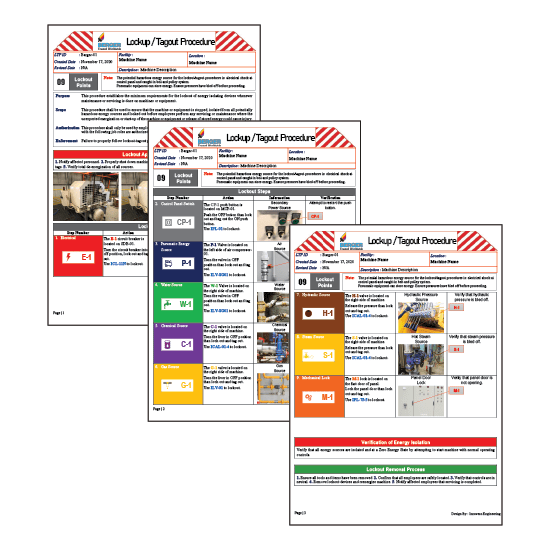POSTED BY:
COMMENTS:
0
POST DATE:
What is Machine Specific Tagout Procedure?
A Machine Specific Lockout Tagout (LOTO) Procedure is a detailed, step-by-step document that outlines the exact sequence for safely shutting down, isolating, and securing equipment from hazardous energy sources before maintenance or servicing begins.
Our Lockout Tagout Procedure service provides you with more than just a template—it delivers a comprehensive, OSHA-compliant program tailored to your specific machinery. We help you create clear, equipment-specific procedures that eliminate confusion, ensure worker safety, and maintain full regulatory compliance across your facility.
What is a Machine-Specific Lockout Tagout Procedure?
A Machine-Specific Lockout Tagout Procedure is a detailed, step-by-step work instruction tailored to a single piece of equipment. It goes beyond the general principles of LOTO and provides a precise roadmap for safely controlling all hazardous energy sources associated with that specific machine.
Think of it this way:
-
Generic LOTO Program: The "rules of the road."
-
Machine-Specific LOTO Procedure: The "detailed driving directions" for a specific vehicle on a specific route.
6 Reasons Why Machine-Specific Procedures are OSHA's Gold Standard
The Occupational Safety and Health Administration (OSHA) standard 29 CFR 1910.147 explicitly requires procedures that are specific to the machine. Here’s why:
-
Addresses Unique Energy Hazards: A robotic welder has different energy hazards (electrical, pneumatic, stored axis energy) than a industrial mixer (electrical, hydraulic, gravitational). A specific procedure accounts for all of them.
-
Eliminates Guesswork: Technicians don't have to deduce which valves, switches, or levers to operate. The procedure provides crystal-clear instructions, reducing human error.
-
Ensures Complex Isolation Scenarios are Managed Correctly: For machines with multiple power sources or complex sequences for shutdown, a generic procedure is useless. A specific procedure provides the necessary sequence.
-
Provides Clear Visual Guides: The best procedures include photos, diagrams, and schematics pinpointing exact isolation points (e.g., "Isolate Main Disconnect Switch A-1 located on the south wall").
-
Streamlines Training and Compliance: New and experienced workers can be trained consistently on the exact same, verified safe procedure for each machine.
-
Strengthens Your Legal Defense: In the event of an incident, having a detailed, machine-specific procedure demonstrates due diligence and a robust safety culture, which is critical for compliance during an OSHA inspection.
Key Elements of an Effective Machine-Specific LOTO Procedure
An OSHA-compliant procedure should be a standalone document that any authorized employee can follow. It must include:
-
Machine Identification: Name, model, serial number, and location.
-
Purpose & Scope: Clearly states when the procedure must be used.
-
Step-by-Step Shutdown Sequence: How to turn off the machine normally.
-
Isolation Points for All Energy Sources: A detailed list and visual map of:
-
Electrical disconnects
-
Pneumatic and hydraulic valves
-
Mechanical energy blocks or pins
-
Thermal energy isolation
-
Chemical line blinds or disconnects
-
Gravitational energy blocks (e.g., for raised beds or arms)
-
-
Stored Energy Dissipation Steps: How to safely release residual energy (e.g., bleed air from a pneumatic line, ground a capacitor).
-
Verification of Isolation: The final, critical step to ensure ZERO energy is present (e.g., "Attempt to start the machine at the local control panel. The machine must not activate.").
-
Restart Sequence: The safe steps to re-energize and return the machine to service.
A Step-by-Step Guide to Developing Your Procedures
Creating these procedures may seem daunting, but a systematic approach makes it manageable.
-
Inventory & Prioritize: List all equipment that requires servicing or maintenance. Prioritize machines with the highest hazard potential.
-
Conduct a Machine-Specific Risk Assessment: A certified safety professional or experienced engineer should identify and document every single energy source on the machine.
-
Document the Steps: Write clear, imperative sentences ("Close Valve V-101," "Lock out Disconnect DB-5"). Avoid jargon.
-
Add Visuals: Take photos. Create diagrams. Circle and label isolation points. A picture is worth a thousand words—and can prevent a deadly mistake.
-
Review & Validate: Have a seasoned maintenance technician and the machine operator walk through the procedure to ensure it is accurate and complete.
-
Train Your Team: Roll out the new procedure with hands-on training for all authorized and affected employees.
-
Audit & Update: Review procedures annually or whenever a machine is modified to ensure they remain accurate.
Conclusion: Don't Gamble with Generic Safety
A generic Lockout Tagout program is a checklist. A Machine-Specific Lockout Tagout Procedure is a culture of safety. It demonstrates a concrete commitment to protecting your most valuable asset: your people.
Investing the time and resources to develop these detailed procedures is one of the most effective actions you can take to prevent workplace tragedies, ensure OSHA compliance, and build a foundation of true operational excellence.
Ready to build a safer, compliant workplace? Start by auditing your highest-risk equipment today and commit to replacing generic guidelines with life-saving, machine-specific procedures.



